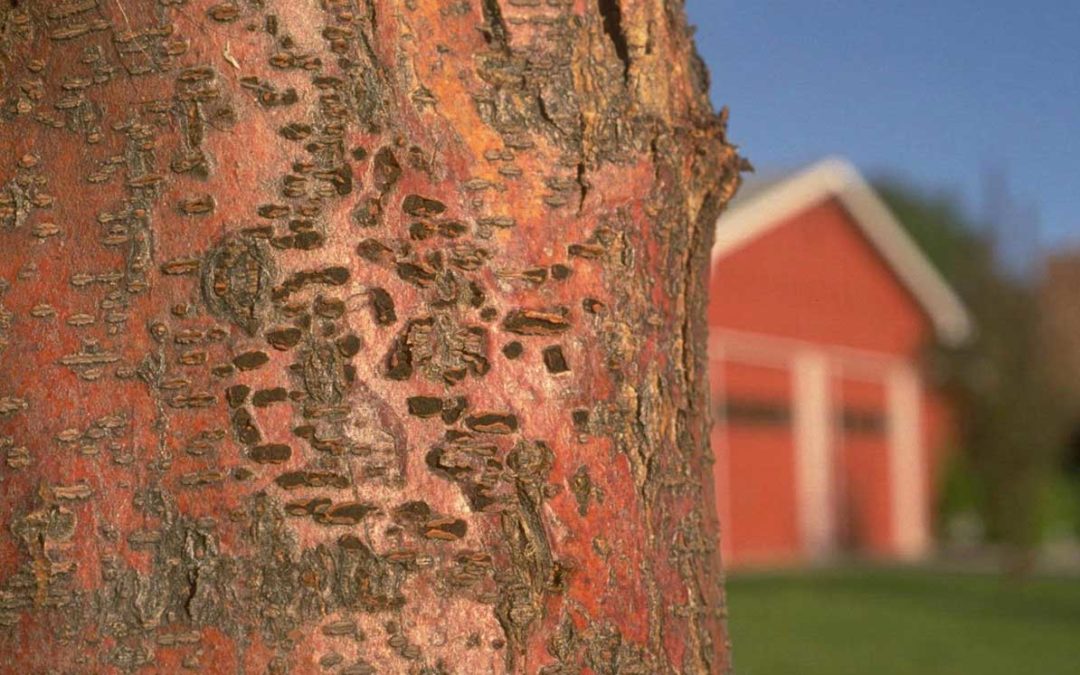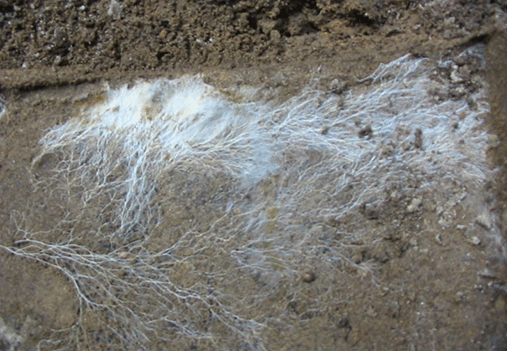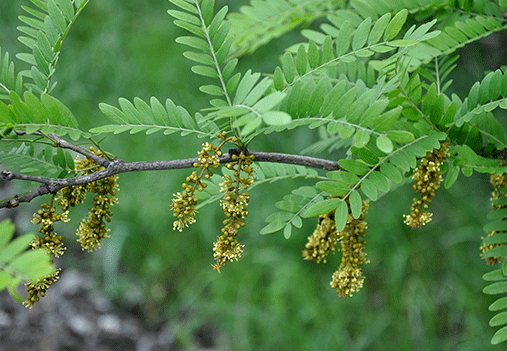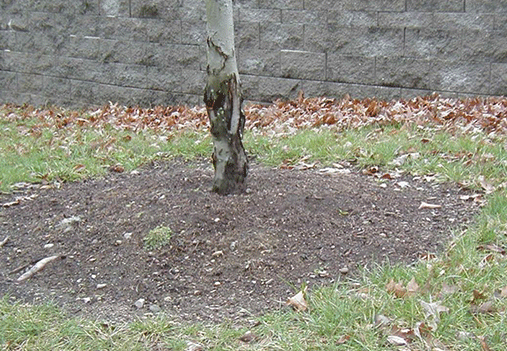Honeylocust Thyronectria Cankers
Over the last two years, the drought and polar plunges that have hit Denver have weakened the ability of Honeylocust trees to fight off disease. Thyronectria cankers are notorious for harming and killing Honeylocusts in the Denver area. Cankers are dried-up areas on the stems and trunks with a different color than the rest of the tree. Thyronectria cankers are elongated and can occur on young or old wood and become bumpy when the fruiting bodies of a fungus break through the bark. For more information, check out the Colorado State Extension bulletin on Honeylocust diseases.
The best defense against Thyronectria and other canker diseases is tree vigor because there is no treatment. Homeowners should keep their trees healthy by prudent watering and pruning each year. Typical canker symptoms are:
- Dieback of affected branches, reduced foliage, yellow foliage, premature fall coloration, and early leaf drop.
- Areas of dead tissue or cankers are found at the base of trees, at branch crotches, around wounds, or on branch stubs.
- Cankers can range from slightly flattened surfaces to distinctly sunken areas with thick, rugged ridges at the canker margin.
- The thin bark areas on stems and branches have a red-yellow discoloration.
- Infected bark and cambium will be loose, and wood beneath them may have a dark, wine-red to yellow discoloration instead of white color.
A canker is a visible injury on the outer part of the tree and is usually the result of an open wound that has become infected. Any injury to the base of a Honeylocust is potentially an entry point for fungi. Most wounds come from careless use of lawnmowers and weed trimmers. Squirrel damage and improper pruning allow fungi to enter stem and trunk tissues. Canker disease tends to be species-specific. Thyronectria cankers are usually found on Honeylocust trees but are often confused with the following fungal infections:
- Cytospora cankers – Attacks Aspens, Spruce, Pine, Poplars, and Willows.
- Phomopsis cankers: Targets Juniper, Russian Olive, Blue Spruce, Douglas-fir, and Arborvitae.
- Nectria cankers – Found on Honeylocust, Oak, and Maple.
Canker diseases pose a severe threat to trees once established because they decrease the delivery of essential nutrients to branches causing dieback. Once the cankers appear on the trunk, it is just a matter of time before the trees die.
Tree Fungal Diseases Common to the Denver Area
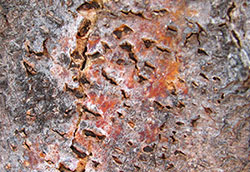
Pleonectria austroamericana
Thyronectria cankers attack Honeylocust trees in Denver. The fungus presents itself as bumpy, disc-shaped asexual fruiting bodies that are light yellow-brown when fresh but blacken with age. Their perithecia or sexual fruiting bodies are reddish-brown in color. Both fruiting bodies start in lenticels or on branches with thin bark. Lenticels are the breathing pores on the bark of trees.
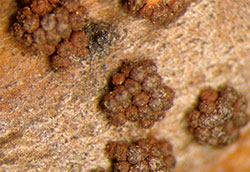
Nectria nigrescens
Black Spot cankers are similar to Thyronectria but have raised asexual fruiting structures that are cream or peach in color. Their perithecia are flask-shaped and reddish-brown and grow in solitary or groupings. Sometimes the perithecia can be found clustered at the base of sporodochia which are compact stroma caused by parasitical fungi. These structures turn dark brown within a few days.
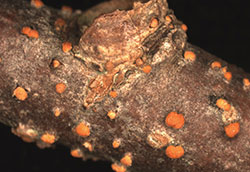
Nectria cinnabarina
Coral Spot Nectria cankers are similar to Thyronectria and Black Spot cankers, but they present as raised smooth sporodochia masses that are creamy colored and look like coral. Their perithecia are small bright reddish-brown round flasks that form in late summer singly or in groups.
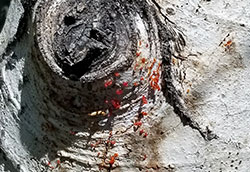
Cytospora
Some Cytospora fungi are host-specific, while others can infect several tree species. Cytospora cankers attack Aspen planted in Denver. Sometimes the fungi attack trees during the fall-winter spring seasons when temperatures are warm, but the tree is dormant and cannot defend itself.

Phomopsis
Typically, Phomopsis usually attacks trees grown in nurseries and Christmas tree farms. For some unknown reason, this fungus is now affecting Evergreens found in yards.
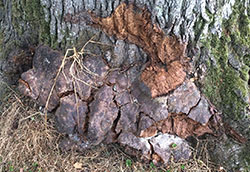
Several fungal pathogens can cause Root Collar Rot. The rot takes advantage of trees affected by Black Spot Nectria or Thyronectria cankers. The disease moves fast, so homeowners with trees that turn early in the fall probably need to call an arborist for proper identification. A tree with rot in advanced stages will need removal.
Disease Cycle
Canker fungi overwinter on infected trees as fruiting structures or grow on dead matter as Mycelium. Mycelium is a fungi growth sometimes seen on the ground or on rotting material that looks like branches of a tree. Wind and rain help spread spores to other parts of the tree or neighboring plants. The spores enter trees through wounds where the fungus grows in the bark, cambium, and outer wood. As the fungi infection spreads, it kills adjacent tissues, eventually girdling affected trees.
Honeylocust Trees
Some Denver trees are more susceptible to cankers than others. The key Denver tree species to watch is the Honeylocust. Thyronectria cankers are now infecting Honeylocusts across the Denver area. Newly planted or transplanted trees are at high risk because they are still acclimating and are not yet fully established. Honeylocust trees have the following characteristics:
- Honeylocust varieties can be thorny or thornless
- The trees grow to 30′ – 70′ ft in height
- The crown is open-spreading and filters light well
- Compound leaves have 8 to 14 leaflets
- Leaves are bright green in summer and turn yellow in the fall
- In late spring and early summer fragrant, small flowers grow in clusters
- Mature Honeylocust trees have grayish-brown bark with long ridges and deep furrows
How Do I Protect My Tree from Cankers?
Because this canker disease usually occurs on a weakened host, the primary control is to reduce stress on trees. Below are common causes of tree stress:
- Drought and Overwatering
Drought and overwatering predispose trees to fungi infection. Overwatering deprives roots systems of oxygen which kills them. To help a tree resist infection, prepare the soil before planting, fertilize, water properly in the winter and summer.
- Mechanical Wounds
Wounds caused by lawnmowers and weed trimmers are frequent entry points for fungi infection. Homeowners and ground crews need to be careful with lawn care equipment around trees.
- Tree Insect Stress
Insects, such as Oystershell Scale and Aphids, create stress and predispose trees to canker diseases. Homeowners with insect infestations should treat their trees promptly before the insects weaken a tree’s immune system.
- Die Back
Once infection occurs, prune the tree to increase plant sanitation by removing all infected limbs and other areas. Pruning invigorates trees and, when done correctly, encourages healthy growth. Be sure to have the tree pruned by a tree service professional who uses sharp tools and avoids damaging branch collars. Certified arborists avoid leaving jagged and rough edges that open trees to infection.
Deep Root Watering and Fertilization
Winter droughts in Denver are common, so trees here need supplemental watering to maintain root system health during the cold months of the year. Believe it or not, the ground does not often freeze here, so winter is an excellent time for deep root watering and fertilization. Not watering creates tree stress, which is why Thyronectria Cankers are such a problem across the City. Ross Tree crews use a deep-root fork to force water down to a depth of 12 inches. We have the equipment to water and fertilize all tree sizes in Denver. Our plant health care trucks bring all we need to the job, saving our customers time and money. Click here for more information about deep root services.
Winter Pruning
Honeylocust trees and other trees affected by canker disease should be pruned and sanitized by removing all infected limbs. Proper tree pruning encourages growth, strong tree structure and improves the aesthetic appeal of a tree. Winter pruning also prepares trees to withstand Denver’s heavy spring snowstorms, whose heavy snows can devastate trees not maintained well. Hiring a reputable tree service company saves money in the long run because tree pruning done right improves tree health, making trees less susceptible to mechanical breakage, tree pests, and diseases. Click here for more information about Standards-Based Tree Pruning.
Homeowners with Honeylocust trees should contact Ross Trees to be checked for Thyronectria Canker. Click here to fill out a request service form or call 303-871-9121.

